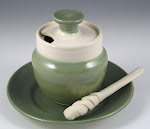Hello from the view at my computer instead of my potter's wheel! It's been photography and photo editing (for clarity only; I promise I'm not making them look other than they should!) and working with Web-a-Deb on the website. Oh my gosh, this stuff takes a year and a day. You know when a pottery woman's fingernails are growing that she hasn't been handling the clay lately.
Down in the studio, the kiln is firing away, cooking up a load of small plates and a few other things. A few lucky duckies get plates from me in a few weeks on Purim. The rest will be for sale. I hope they come out as nice as I think they will...
I haven't exactly been idle. With the anniversary of my mother's death coming up, I am thinking of what to say, since I usually speak at our annual family gathering on this date. So I have been trip-trapping over the bridge of time to letters and relatives' memories of an era before I was born. It is like existing in another dimension for a little while, then resurfacing. I am fascinated, and honestly, it is bittersweet, because my mother is close to my heart.
But back to art, since I digress here from clay ruminations, as I have in life recently! The Newark Museum in Newark, NJ, is a strange configuration of rooms with all sorts of items grouped in relatively small collections, into time periods and art movements. I had to wander a bit, even with map in hand- and it was interesting wandering, with some highlights!- but eventually I found my destination.
Off in one little room, all by themselves, are the ceramic objects that I had come especially to see. To nourish my curiosity and my heart and mind, suffering clay withdrawal due to all the other things that have occupied me, I stood before each piece and took it in. It may sound crazy, but I felt myself absorbing their presence almost with a little whoosh of induction. Toshiko Takaezu's forms, in smooth stony colors, like moons, some round, or tall, cylindrical, like rocks: these closed forms are so quiet and yet so strong at the same time. Some have vestiges of an almost-opening, a tiny conical peak at their very top to remind that these were, indeed, created in the same methods as utilitarian vessels. They are meant to be part of a landscape, I think, though when grouped together, they are a landscape.
There is nothing showy about them, but Takaezu's forms satisfy something so powerful within me that I seek them out wherever they are on display. One of the forms was a garden seat. It is just a sort of short, voluminous round stalk that flares out as it proceeds upward from the ground, terminating in a very slightly convex top that can be used as a seat. It is easy to visualize it set in grass or sand, a perch from which to absorb the smell of earth, sound of birds, feel of wind.
The garden seat form is symbolic to me. Sometimes I am reminded of what it is to just be quiet and observe the life around us. Eventually, I find, it likes to spill over into my work.
Toshiko is in her 80s now. Long life to her!
http://www.clevelandartsprize.org/awardees/toshiko_takaezu.html
Thursday, February 4, 2010
Subscribe to:
Post Comments (Atom)

In response to questions how to sign up for an RSS feed, on my mac there is an RSS symbol that appears right in the URL box. If you click on it, you can then follow directions on how to sign up.
ReplyDeleteI hope this works for you all!